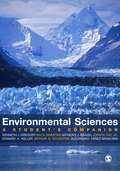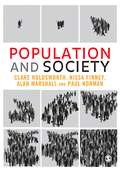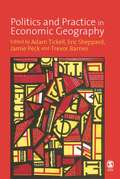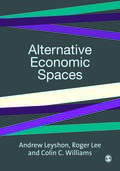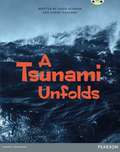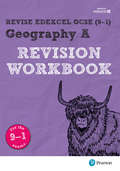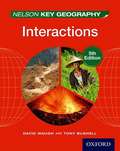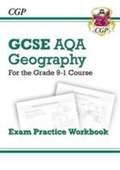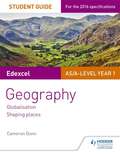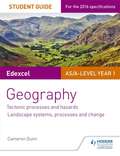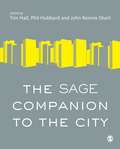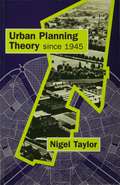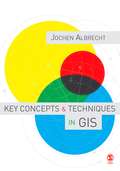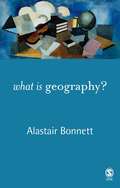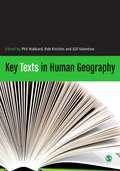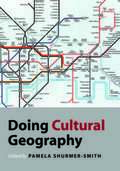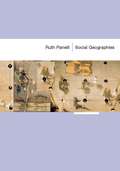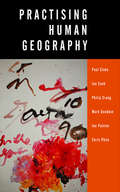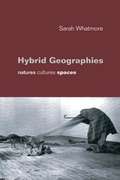- Table View
- List View
Environmental Sciences: A Student's Companion (PDF)
by Anthony Brazel Alejandro Yanez-Arancibia Arthur G Sylvester Edward A Keller John W Day K J Gregory Professor Ian SimmonsUnique in the reference literature, this Companion provides students with an introduction to all the major concepts and contemporary issues in the environmental sciences. The text is divided into six sections (Environmental Sciences, Environments, Paradigms and Concepts, Processes and Dynamic, Scales and Techniques, Environmental Issues), with over 200 entries alphabetically organized and authored by key names in the environmental science disciplines. Entries are concise, informative, richly visual and fully referenced and cross referenced. They introduce key concepts and processes that are included in the index, cite relevant websites, and reflect the latest thinking.
Population and Society (PDF)
by Alan Marshall Dr Clare Holdsworth Dr Paul D Norman Nissa Finney"An excellent introduction to the study of population and its significance for many of the key social, political, cultural and environmental issues facing the world today. It covers population growth, ageing, migration and mobility, parenting, health inequalities, and much more... The authors do not shy away from areas of continuing debate, providing both sides of an argument and encouraging readers to follow up the original sources" - Tony Champion, Emeritus Professor of Population Geography, Centre for Urban, Regional & Development Studies, Newcastle University and Vice President, British Society for Population Studies, 2011-2013 Population and Society is an undergraduate introduction to population that explains the latest trends in population studies. The text provides a detailed and completely accessible overview that: situates demographic events - fertility, mortality and migration - within the context of broader social impacts and theorisations like social inequalities, individualisation and life course analysis uses global illustrative examples to demonstrate the importance of data and data interpretation in population studies is illustrated throughout with pedagogic features, like chapter opening summaries, suggestions for further readings and case study examples. This text will be widely used as the standard and most up-to-date text on population and society for courses across the social sciences.
Politics and Practice in Economic Geography (PDF)
by Eric Sheppard Jamie Peck Professor Adam Tickell Trevor Barnes"The biggest strength of the book is its pedagogic design, which will appeal to new entrants in the field but also leaves space for methodological debates... It is well suited for use on general courses but it also involves far more than an introduction and is full of theoretical insights for a more theoretically advanced audience." - Economic Geography Research Group In the last fifteen years economic geography has experienced a number of fundamental theoretical and methodological shifts. Politics and Practice in Economic Geography explains and interrogates these fundamental issues of research practice in the discipline. Concerned with examining the methodological challenges associated with that 'cultural turn', the text explains and discusses: qualitative and ethnographic methodologies the role and significance of quantitative and numerical methods the methodological implications of both post-structural and feminist theories the use of case-study approaches the methodological relation between the economic geography and neoclassical economics, economic sociology, and economic anthropology. Leading contributors examine substantive methodological issues in economic geography and make a distinctive contribution to economic-geographical debate and practice.
Alternative Economic Spaces (PDF)
by Andrew Leyshon Mr Colin C Williams Roger Lee`A hopeful but nonetheless hard-hitting analysis of alternative economic spaces proliferating in the belly of the capitalist beast. In this book Leyshon, Lee and Williams convene fascinating studies of exchange, enterprise, credit and community. They invite us onto a new and promising discursive terrain where we can analyze, criticize and above all recognize actually existing economies of diversity in the wealthy countries of the West' - J K Gibson-Graham, Australian National University and University of Massachusetts, Amherst In the context of problems in the `new economy' - from dot.com start-ups, high-technology, and telecoms - Alternative Economic Spaces presents a critical evaluation of alternatives to the global economic mainstream. It focuses on the emergence of alternative economic geographies within developed economies and analyzes the emergence of alternative economic practices within industrialized countries. These include the creation of institutions like Local Exchange and Trading Systems, Credit Unions, and other social economy initiatives; and the development of alternative practices from informal work to the invention of consumption sites that act as alternatives to the monoply of the `big-box', multi-chain retail outlets. Alternative Economic Spaces is a reconsideration of what is meant by the `economic' in economic geography; its objective is to bring together some of the ways in which this is being undertaken. The volume shows how the `economic' is being rethought in economic geography by detailing new economic geographies as they are emerging in practice.
Bug Club Comprehension Year 6 A Tsunami Unfolds (PDF)
by Susan Korman Kimiko KajikawaThe 2011 Japanese tsunami was one of the most powerful natural disasters ever recorded. What was it like to be there, and what happened next'. Track the tsunami through the experiences of people who lived through this extraordinary event.
Revise Edexcel GCSE: For the 9-1 Exams (PDF) (Revise Edexcel GCSE Geography 16)
by Alison BarracloughOur Revision Workbooks help you develop vital skills throughout your course in preparation for the exam with: One-to-one page match with the Revision Guide so you can find the practice you need quickly and easily Guided practice questions on every page demonstrate good technique and build confidence Loads of practice questions in the style of the new exams, with plenty of practice at problem-solving and reasoning skills Hints and tips helps you avoid common pitfalls Full set of practice papers written to match the new specification exactly
Nelson Key Geography Interactions (PDF)
by David Waugh Tony BushellThis new edition of David Waugh and Tony Bushell's Key Geography provides the support you need to deliver the 2014 KS3 Programme of Study, with a focus on developing key geographical skills and techniques to prepare students for Key Stage 4. The Interactions Student Book includes chapters on China and Plate tectonics. To request your Nelson Key Geography evaluation pack, please email fiona. mccollum@oup. com with your name and school address. 9781408527320
New Grade 9-1 GCSE Geography AQA Exam Practice Workbook (PDF)
by Cgp BooksThis brilliant CGP Workbook is packed with realistic exam-style questions for Grade 9-1 AQA GCSE Geography - it’s the perfect way to prepare for the real exams! Every Physical and Human Geography topic is covered, and there’s plenty of practice for the new Paper 3 (Issue Analysis and Fieldwork). Complete answers are printed in a separate booklet (9781782946120). Matching study notes for this course are available in CGP’s AQA GCSE Geography Revision Guide (9781782946106).
Edexcel AS/A-level Geography Student Guide 2: Globalisation; Shaping places (PDF)
by Cameron DunnExam Board: Edexcel Level: AS/A-level Subject: Geography First Teaching: September 2016 First Exam: September 2017 Reinforce students' geographical understanding throughout their course; clear topic summaries with sample questions and answers help students improve their exam technique and achieve their best. Written by a teacher with extensive examining experience, this guide: - Helps students identify what they need to know with a concise summary of the topics examined at AS and A-level - Consolidates understanding through assessment tips and knowledge-check questions - Offers opportunities for students to improve their exam technique by consulting sample graded answers to exam-style questions - Develops independent learning and research skills - Provides the content students need to produce their own revision notes 9781471865695
Edexcel AS/A-level Geography Student Guide 1: Tectonic Processes and Hazards; Landscape systems, processes and change (PDF)
by Cameron DunnExam Board: Edexcel Level: AS/A-level Subject: Geography First Teaching: September 2016 First Exam: September 2017 Reinforce students' geographical understanding throughout their course; clear topic summaries with sample questions and answers help students improve their exam technique and achieve their best. Written by a teacher with extensive examining experience, this guide: - Helps students identify what they need to know with a concise summary of the topics examined at AS and A-level - Consolidates understanding through assessment tips and knowledge-check questions - Offers opportunities for students to improve their exam technique by consulting sample graded answers to exam-style questions - Develops independent learning and research skills - Provides the content students need to produce their own revision notes 9781471863172
Fossil fuel power station (UEB uncontracted)
by RnibThis is a labelled cross section diagram of a fossil fuel power station, showing the process of producing electrical power from fossil fuels such coal, coke, gas and oil, and also wood and bio fuels (oils and gases from plant sources). There is a locator dot shown, which will be at the top left of the page when the image is the correct way up. The image is surrounded by a dashed line image border. The diagram is in four main sections. From left to right these are: the boiler, the steam turbine, the generator and the cooling tower. The fuel comes into the boiler on the left of the page through a pipe and is burnt to create a high temperature inside the boiler. To the right is the steam turbine. A pipe carries water from the bottom of the turbine enclosure to the left, into a heat exchanger in the boiler, where it is heated to create steam at high pressure. This travels to the right through a pipe to rotate the turbine blades at high speed. To the right, a generator, driven by the rotation of the turbine produces an alternating electric current, which is fed into the national electricity grid. To the right of the generator you can find a cooling tower. Hot water from a condenser in the turbine housing is pumped to water jets in the cooling tower and sprayed into a tank to cool. The cold water is then pumped back to the condenser in the turbine housing to condense the steam from the turbine.
Fossil fuel power station (large print)
by RnibThis is a labelled cross section diagram of a fossil fuel power station, showing the process of producing electrical power from fossil fuels such coal, coke, gas and oil, and also wood and bio fuels (oils and gases from plant sources). There is a locator dot shown, which will be at the top left of the page when the image is the correct way up. The image is surrounded by a dashed line image border. The diagram is in four main sections. From left to right these are: the boiler, the steam turbine, the generator and the cooling tower. The fuel comes into the boiler on the left of the page through a pipe and is burnt to create a high temperature inside the boiler. To the right is the steam turbine. A pipe carries water from the bottom of the turbine enclosure to the left, into a heat exchanger in the boiler, where it is heated to create steam at high pressure. This travels to the right through a pipe to rotate the turbine blades at high speed. To the right, a generator, driven by the rotation of the turbine produces an alternating electric current, which is fed into the national electricity grid. To the right of the generator you can find a cooling tower. Hot water from a condenser in the turbine housing is pumped to water jets in the cooling tower and sprayed into a tank to cool. The cold water is then pumped back to the condenser in the turbine housing to condense the steam from the turbine.
Fossil fuel power station (UEB contracted)
by RnibThis is a labelled cross section diagram of a fossil fuel power station, showing the process of producing electrical power from fossil fuels such coal, coke, gas and oil, and also wood and bio fuels (oils and gases from plant sources). There is a locator dot shown, which will be at the top left of the page when the image is the correct way up. The image is surrounded by a dashed line image border. The diagram is in four main sections. From left to right these are: the boiler, the steam turbine, the generator and the cooling tower. The fuel comes into the boiler on the left of the page through a pipe and is burnt to create a high temperature inside the boiler. To the right is the steam turbine. A pipe carries water from the bottom of the turbine enclosure to the left, into a heat exchanger in the boiler, where it is heated to create steam at high pressure. This travels to the right through a pipe to rotate the turbine blades at high speed. To the right, a generator, driven by the rotation of the turbine produces an alternating electric current, which is fed into the national electricity grid. To the right of the generator you can find a cooling tower. Hot water from a condenser in the turbine housing is pumped to water jets in the cooling tower and sprayed into a tank to cool. The cold water is then pumped back to the condenser in the turbine housing to condense the steam from the turbine.
United Nations Logo (Tactile)
by Adrian FarnsworthThis is a tactile image of the United Nations logo. At the centre of the page is an image of the Earth seen from above showing its lines of latitude and longitude. It is surrounded by two olive branches representing peace. The shapes of the Earths land masses have been omitted in this tactile version.
Symbols & Trademarks (Tactile)
by Adrian FarnsworthThis is a four-page document showing commonly-used symbols and trademarks. There are four on page one, three on each of pages two and three, and two on page four. The Woolmark on page two is a registered trade mark of The Woolmark Company and the Golden Arches logo on page four is a registered trade mark of the McDonald's Corporation.
World Map (Large Print)
by RnibThis is a map of the world. The map is framed by a dashed image border. There is a locator dot shown, which will be at the top left of the page when the image is the right way up. All land masses are textured (green) and sea areas are untextured (blue). On the left of the page are North and South America, in the centre Europe and Africa and to the right Asia and Australasia. Some areas have been given two-letter alphabetic labels due to space considerations. These are described in a key at the bottom left of the page.
The SAGE Companion to the City (PDF)
by Timothy Hall Professor John Rennie Short Phil Hubbard"This book pulls together an exceptional range of literature in addressing the complexity of contemporary patterns and processes of urbanization. It offers a rich array of concepts and theories and is studded with fascinating examples that illustrate the changing nature of cities and urban life" - Paul Knox, Virginia Tech University "The SAGE Companion to the City is a tour-de-force of contemporary urban studies. At once a stocktake, showcase and springboard for scholarly approaches to cities and city life, the editors have assembled a cohesive and convincing set of lucid, insightful and critical essays of great quality. Eschewing grand theory and deadening encyclopediasm, the contributors refresh both longstanding concerns and explore new themes in ways both brilliantly accessible to newcomers and satisfying to the cognoscenti." - Robert Freestone, University of New South Wales Organized in four sections The SAGE Companion to the City provides a systematic A-Z to understanding the city that explains the interrelations between society, culture and economy. Histories: explores power, religion, science and technology, modernity, and the landscape of the city. Economies and Inequalities: explores work and leisure, globalisation, innovation, and the role of the state. Communities: explores migration and settlement, segregation and division, civility, housing and homelessness. Order and Disorder: explores politics and policy, planning and conflict, law and order, surveillance and terror. An accessible guide to all areas of urban studies, the text offers both a contemporary cutting edge reflection and measured historical and geographical reflection on urban studies. It will be essential reading for students of any discipline interested in the city as an object of study.
Urban Planning Theory since 1945
by Dr Nigel TaylorFollowing the Second World War, modern systems of urban and regional planning were established in Britain and most other developed countries. In this book, Nigel Taylor describes the changes in planning thought which have taken place since then. He outlines the main theories of planning, from the traditional view of urban planning as an exercise in physical design, to the systems and rational process views of planning of the 1960s; from Marxist accounts of the role of planning in capitalist society in the 1970s, to theories about planning implementation, and more recent views of planning as a form of `communicative action'.
Key Concepts and Techniques in GIS
by Jochen AlbrechtKey Concepts and Techniques in GIS is a concise overview of the fundamental ideas that inform geographic information science. It provides detailed descriptions of the concepts and techniques that anyone using GIS software must fully understand to analyse spatial data. Short and clearly focussed chapters provide explanations of: spatial relationships and spatial data the creation of digital data, the use and access of existing data, the combination of data the use of modelling techniques and the essential functions of map algebra spatial statistics and spatial analysis geocomputation - including discussion of neural networks, cellular automata, and agent-based modelling Illustrated throughout with explanatory figures, the text also includes a glossary, cross referenced to discussion in the text. Written very much from a user's perspective, Key Concepts and Techniques in GIS is highly readable refresher course for intermediate level students and practitioners of GIS in the social and the natural sciences.
What is Geography?
by Alastair Bonnett"I cannot imagine a better guide to the transition between school and undergraduate geography than this short, informative and confidently-argued book. Written without fuss but based on solid learning and clear thinking, it tackles head-on a question many professional academic geographers would rather avoid." - Alisdair Rogers, University of Oxford "A beautiful little book that helps to introduce the core concepts of geography and provides an ideal framework for relating other fields of knowledge and academia." - Stefan Zimmermann, University of Osnabruck What is Geography? Geography is a fundamental fascination with, and a crucial method for, understanding the way the world works. This text offers readers a short and highly accessible account of the ideas and concepts constituting geography. Drawing out the key themes that define the subject, What is Geography? demonstrates how and why these themes - like environment and geopolitics- are of fundamental importance. Including discussion of both the human and the natural realms, the text looks at key themes like environment, space, and place - as well as geography's methods and the history of the discipline. Introductory but not simplified, What is Geography? will provide students with the ability to understand the history and context of the subject without any prior knowledge. Designed as a key transitional text for students entering undergraduate courses, this book will be of interest to all readers interested in and intrigued by the "geographical imagination".
Key Texts in Human Geography (PDF)
by Rob Kitchin Phil Hubbard Gill Valentine"A book that will delight students… Key Texts in Human Geography is a primer of 26 interpretive essays designed to open up the subject's landmark monographs of the past 50 years to critical interpretation... The essays are uniformly excellent and the enthusiasm of the authors for the project shines through… It will find itself at the top of a thousand module handouts." - THE Textbook Guide "Will surely become a ‘key text’ itself. Read any chapter and you will want to compare it with another. Before you realize, an afternoon is gone and then you are tracking down the originals." - Professor James Sidaway, University of Plymouth 'An essential synopsis of essential readings that every human geographer must read. It is highly recommended for those just embarking on their careers as well as those who need a reminder of how and why geography moved from the margins of social thought to its very core." - Barney Warf, Florida State University Undergraduate geography students are often directed to 'key' texts in the literature but find them difficult to read because of their language and argument. As a result, they fail to get to grips with the subject matter and gravitate towards course textbooks instead. Key Texts in Human Geography serves as a primer and companion to the key texts in human geography published over the past 40 years. It is not a reader, but a volume of 26 interpretive essays highlighting: the significance of the text how the book should be read reactions and controversies surrounding the book the book's long-term legacy. It is an essential reference guide for all students of human geography and provides an invaluable interpretive tool in answering questions about human geography and what constitutes geographical knowledge.
Doing Cultural Geography
by Dr Pamela Shurmer-SmithDoing Cultural Geography is an introduction to cultural geography that integrates theoretical discussion with applied examples. The emphasis throughout is on doing. Recognising that many undergraduates have difficulty with both theory and methods courses, the text demystifies the 'theory' informing cultural geography and encourages students to engage directly with theory in practice. It emphasises what can be done with humanist, Marxist, post-structuralist, feminist, and post-colonial theory, demonstrating that this is the best way to prompt students to engage with the otherwise daunting theoretical literature. Twenty short chapters are grouped into five sections on Theory, Topic Selection, Methodology, Interpretation and Presentation. The main text is intercut with questions, suggestions for activities and short sample extracts from scholarly texts, chosen to exemplify the subject of the chapter and to stimulate further reading. Chapters conclude with glossaries and suggestions for further reading. Doing Cultural Geography will facilitate project work from small, classroom-based activities to the planning stages of undergraduate research projects. It will be essential reading for students in modules in cultural geography and foundation courses in human geography and theory and methods.
Social Geographies: From Difference to Action (PDF)
by Dr Ruth PanelliHow do we describe ourselves? Where have we, do we, will we, live our lives? Why are the differences between people a source of tension? How can social change occur? Social geography can assist in addressing these questions. It provides ways of understanding and living in our contemporary world. Providing students with the resources to understand both the theoretical and empirical approaches social geographers take when investigating social difference, this text outlines key theoretical approaches and traces the core geographies of difference: class, gender, race/ethnicity, and sexuality. It concludes by showing how geographers work across these ideas of difference to understand questions of identity, power and action. Using illustrative examples from around the world, Social Geographies includes: - Individual chapters on the main theoretical approaches to difference - Individual chapters on the key concepts of identity, power and action - Reviews of the core literature, with suggestions for further reading - Biographies of key contemporary social geographers - Glossary of key terms For students beginning human geography courses, or in social geography modules, this book is the essential primer.
Practising Human Geography (PDF)
by Professor Paul J Cloke Professor Mark A Goodwin Philip Crang Joe Painter Ian Cook Christopher Philo Philo'Filling an enormous gap in the geographic literature, here is a terrific book that shows us how to think about and practice human geographic research' - Professor Jennifer Wolch, University of Southern California `Practising Human Geography lucidly, comprehensively, and sometimes passionately shows why methodology matters, and why it is often so hard. To choose a method is to choose the kind of geographical values one wants to uphold. You need to get it right.These authors do' - Trevor Barnes, University of British Columbia `Practising Human Geography is a godsend for students. Written in an accessible and engaging style, the book demystifies the study of geographical methodology, offering a wealth of practical advice from the authors' own research experience. This is not a manual of approved geographical techniques. It is a reflexive, critical and highly personal account, combining historical depth with up-to-the-minute examples of research in practice. Practising Human Geography is a comprehensive and theoretically informed introduction to the practices of fieldwork, data collection, interpretation and writing, enabling students to make sense of their own data and to develop a critical perspective on the existing literature. The book makes complicated ideas approachable through the effective use of case studies and a firm grasp of contemporary debates' - Peter Jackson, Professor of Human Geography, University of Sheffield Practising Human Geography is a critical introduction to key issues in the practice of human geography, informed by the question 'how do geographers do research?' In examining those methods and practices that are essential to doing geography, the text presents a theoretically-informed discussion of the construction and interpretation of geographical data - including: the use of core research methodologies; using official and non-official sources; and the interpretative role of the researcher. Framed by an overview of how ideas of practising human geography have changed, the twelve chapters offer a comprehensive and integrated overview of research methodologies. The text is illustrated throughout with text boxes, case studies, and definitions of key terms. Practising Human Geography will introduce geographers - from undergraduate to faculty - to the core issues that inform research design and practice.
Hybrid Geographies: Natures Cultures Spaces (PDF)
by Sarah Whatmore`Hybrid Geographies is one of the most original and important contributions to our field in the last 30 years. At once immensley provocative and productive, it is written with uncommon clarity and grace, and promises to breathe new life not only into geographical inquiry but into critical practice across the spectrum of the humanities and social sciences - and beyond. An extraordinary achievement' - Professor Derek Gregory, Department of Geography, University of British Columbia Hybrid Geographies critically examines the `opposition' between nature and culture, the material and the social, as represented in scientific, environmental and popular discourses. Demonstrating that the world is not an exclusively human achievement, Hybrid Geographies reconsiders the relation between human and non-human, the social and the material, showing how they are intimately and variously linked. General arguments - informed by work in critical geography, feminist theory, environmental ethics, and science studies - are illustrated throughout with detailed case-study material. This exemplifies the two core themes of the book: a consideration of hybridity (the human/non-human relation) and of the `fault-lines' in the spatial organization of society and nature. Hybrid Geographies is essential reading for students in the social sciences with an interest in nature, space and social theory.
